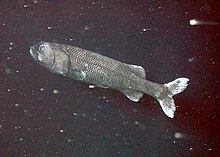| Slickheads Temporal range:
| |
|---|---|

| |
| California slickhead, Alepocephalus tenebrosus | |
|
Scientific classification
| |
| Domain: | Eukaryota |
| Kingdom: | Animalia |
| Phylum: | Chordata |
| Class: | Actinopterygii |
| Superorder: | Alepocephali |
| Order: | Alepocephaliformes |
| Family: |
Alepocephalidae Bonaparte, 1846 |
| Genera | |
| Synonyms | |
| |
Slickheads, also known as nakedheads or smoothheads, are deep water fishes that belong to the family Alepocephalidae. They are most commonly found in the bathypelagic layer, which is approximately 3000m below the surface. [1] They get their name from the lack of scales on their heads. Similarly, the scientific name is from the Greek ᾰ̓- (a-, "not"); λέπος (lepos, "scale"); and κεφαλή (kephalē, "head"). It has about 22 genera with ca. 96 species. [2]
The only known fossil genus is Carpathichthys from the Early Oligocene of Poland, although an undescribed species of Bathyprion and several indeterminate taxa are also known from the same formation. Fossil otoliths are also known, dating to the Early Eocene. [3] [4]
Description
The following characteristics are generally shared by the Alepocephalidae family:
Their mouths consist of 80 to 100 razor-sharp teeth, being rather small and feeble. They are shaped in an eel-like elongation, with large eyes, gill rakers that range from moderate to long and numerous, and spineless fins. The single dorsal fin is located posterior to the midpoint of the body and there is no adipose dorsal fin present, there is a pectoral fin ranging from small to rudimentary located below the mid-flank, 4-18 rays, if pelvic fins are present, they exist in the abdominal region, with the origin being before the origin of the dorsal fin, they have forked caudal fins, and a tube above the base of pectoral fin that connects to a luminous gland on the shoulder girdle. They have no swim bladder. [2] Some species bear photophores. [5]
Their early life development is from large eggs directly into yolk sac juveniles that travel in deep waters. [6]
The largest species is the Yokozuna slickhead, Narcetes shonanmaruae. [7]
Behaviour
It’s been thought that as the Alepocephalidae age, they move down layers in the ocean, (mesopelagic waters and bathypelagic waters) due to mostly adolescent Alepocephalidae being reported near the surface, although there have been sightings of juveniles only several meters above the sea floor, which could suggest that some species may travel between different depths throughout their life stages, a vertical shift. [8]
Vertical shift could occur due to predation being higher close to the sea floor and/or warmer water having a larger abundance of plankton. Juvenile slickheads may have a preference to travel upwards to take advantage of the lack of predation and abundance of food to increase survival rates. [9]
Distribution
The species of Alepocephalidae are widely distributed throughout the world and can be found in the Atlantic, Indian, and western Pacific oceans, [10] although they are difficult to find as they typically live around the bathypelagic layer of the ocean.
References
- ^ McEachran, J.; Fechhelm, J.D. (1998). Fishes of the Gulf of Mexico, Vol. 1: Myxiniformes to Gasterosteiformes. Fishes of the Gulf of Mexico. Austin: University of Texas Press. p. 381. ISBN 978-0-292-75206-1. OCLC 38468784. Retrieved 12 July 2021.
- ^ a b ANGULO, ARTURO; BALDWIN, CAROLE C.; ROBERTSON, D. ROSS (2016-01-18). "<strong>A new species of <em>Leptoderma</em> Vaillant, 1886 (Osmeriformes: Alepocephalidae) from the Pacific coast of Central America</strong>". Zootaxa. 4066 (4): 493–500. doi: 10.11646/zootaxa.4066.4.10. hdl: 10669/73336. ISSN 1175-5334. PMID 27395850.
- ^ Kotlarczyk, Janusz; Jerzmańska, Anna; Świdnicka, Ewa; Wiszniowska, Teresa (2006). "A framework of ichthyofaunal ecostratigraphy of the Oligocene-Early Miocene strata of the Polish Outer Carpathian basin". Annales Societatis Geologorum Poloniae. 76 (1): 1–111.
- ^ Near, Thomas J.; Thacker, Christine E. (2024). "Phylogenetic Classification of Living and Fossil Ray-Finned Fishes (Actinopterygii)". Bulletin of the Peabody Museum of Natural History. 65 (1): 3–302. doi: 10.3374/014.065.0101. ISSN 0079-032X.
-
^ Nelson, Joseph S., Terry C. Grande, and Mark V.H. Wilson (2016). Fishes of the World. John Wiley & Sons. pp. 173–174.
{{ cite book}}: CS1 maint: multiple names: authors list ( link) - ^ Moser, H. Geoffrey (1996). The Early Stages of Fishes in the California Current Region: Final Report. U.S. Department of the Interior, Minerals Management Service, Pacific OCS Region.
- ^ Fujiwara, Yoshihiro; Kawato, Masaru; Poulsen, Jan Yde; Ida, Hitoshi; Chikaraishi, Yoshito; Ohkouchi, Naohiko; Oguri, Kazumasa; Gotoh, Shinpei; Ozawa, Genki; Tanaka, Sho; Miya, Masaki (2021-01-25). "Discovery of a colossal slickhead (Alepocephaliformes: Alepocephalidae): an active-swimming top predator in the deep waters of Suruga Bay, Japan". Scientific Reports. 11 (1): 2490. Bibcode: 2021NatSR..11.2490F. doi: 10.1038/s41598-020-80203-6. ISSN 2045-2322. PMC 7835233. PMID 33495481.
- ^ Takami, Munehiro; Fukui, Atsushi (2010-08-12). "Larvae and juveniles of Leptoderma lubricum and L. retropinnum (Argentiformes: Alepocephalidae) collected from Suruga Bay, Japan". Ichthyological Research. 57 (4): 406–415. doi: 10.1007/s10228-010-0176-0. ISSN 1341-8998. S2CID 24825738.
- ^ Shiao, J. C.; Liu, E. Y.; Sui, T. D. (2016-01-29). "Up-and-down shift in residence depth of slickheads (Alepocephalidae) revealed by otolith stable oxygen isotopic composition". Journal of Fish Biology. 88 (3): 1265–1272. doi: 10.1111/jfb.12904. ISSN 0022-1112. PMID 26822590.
- ^ ANGULO, ARTURO; BALDWIN, CAROLE C.; ROBERTSON, D. ROSS (2016-01-18). "<strong>A new species of <em>Leptoderma</em> Vaillant, 1886 (Osmeriformes: Alepocephalidae) from the Pacific coast of Central America</strong>". Zootaxa. 4066 (4): 493–500. doi: 10.11646/zootaxa.4066.4.10. hdl: 10669/73336. ISSN 1175-5334. PMID 27395850.
- R. Betancur-Rodriguez, E. Wiley, N. Bailly, A. Acero, M. Miya, G. Lecointre, G. Ortí: Phylogenetic Classification of Bony Fishes – Version 4 Archived 2017-07-11 at the Wayback Machine (2016)
- Froese, Rainer, and Daniel Pauly, eds. (2013). "Alepocephalidae" in FishBase. October 2013 version.
- "Alepocephalidae". Integrated Taxonomic Information System.
- Tony Ayling & Geoffrey Cox, Collins Guide to the Sea Fishes of New Zealand, (William Collins Publishers Ltd, Auckland, New Zealand 1982) ISBN 0-00-216987-8
- Byrkjedal, I., Poulsen, J.Y., & Galbraith, J. (2011). "Leptodermua macrophthalmum n.sp., a new species of smooth-head (Otocephala: Alepocephalidae) from the Mid Atlantic Ridge." Zootaxa 2876: 49–56.
External links